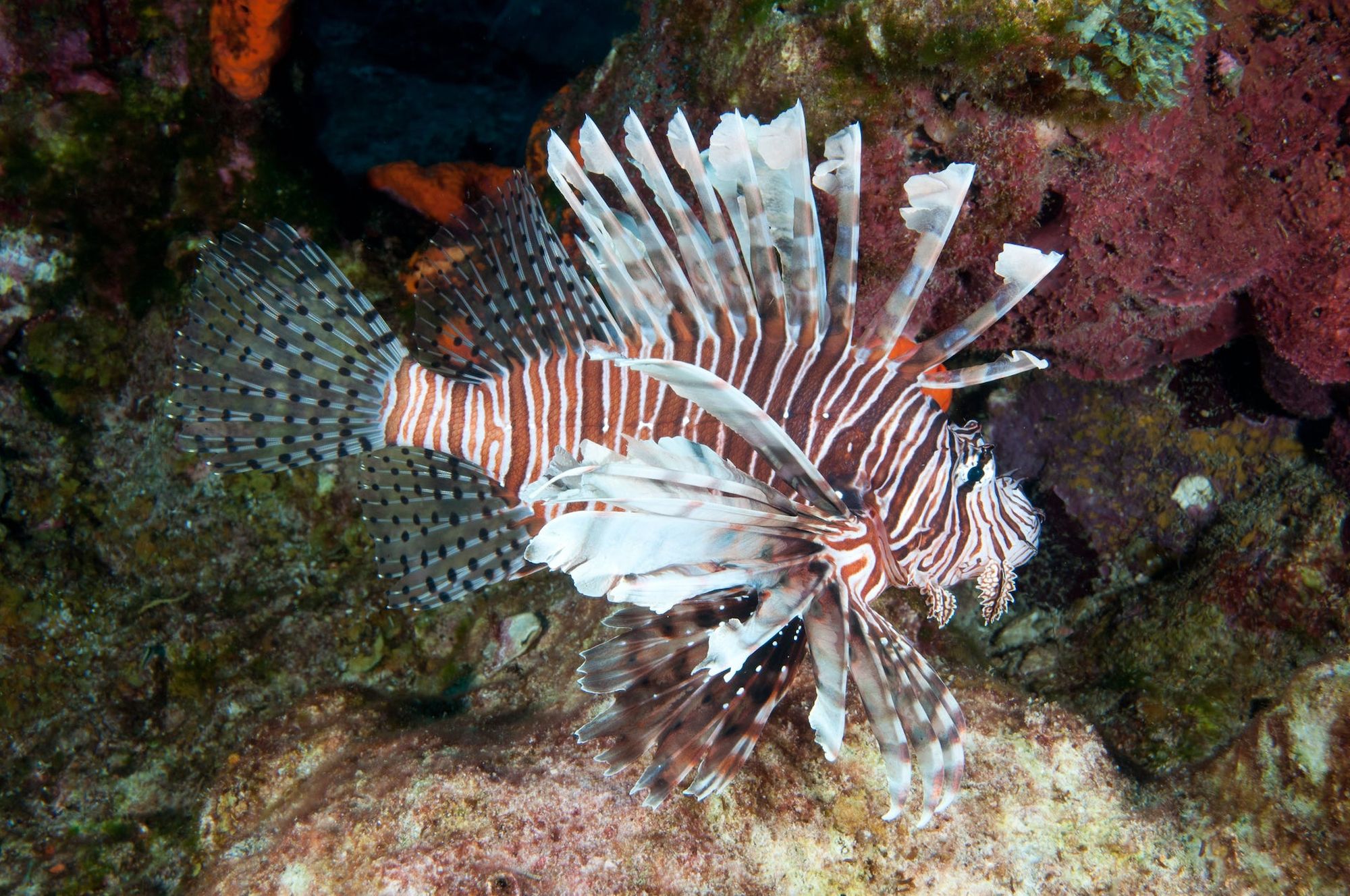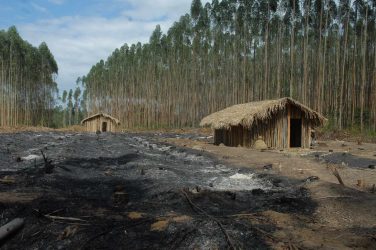Brazil’s coastal waters teem with a rich array of species that paint a living tapestry beneath the waves. This underwater world is particularly special because many of its species are endemic – they are found nowhere else on Earth. The southwestern Atlantic is home to 111 endemic reef fish species, each of which plays a crucial role in the intricate web of marine life.
An uninvited guest has arrived in these tropical waters: the Pacific red lionfish (Pterois volitans). Renowned for its stunning appearance and voracious appetite, the lionfish was first detected off of Florida in 1985 and has spread throughout the Caribbean, killing reef fish in large numbers.
Now it has breached a formidable obstacle: the Amazon-Orinoco river plume, which flows into the Atlantic from northeastern Brazil. This massive discharge of fresh water has long functioned as a barrier separating Caribbean fish species from those farther south along Brazil’s coastline.
Scientists and environmental managers widely agree that the lionfish invasion in Brazil is a potential ecological disaster. As a marine ecologist, I believe mitigating the damage will require a comprehensive approach that addresses the ecological, social and economic harms wrought by this predatory fish.
Lionfish have no known predators and feed on the juveniles of important commercial fish species, such as grouper and snapper.
Tracing the lionfish’s spread
It’s easy to see why lionfish appeal to aquarium enthusiasts. Native to the warm waters of the Indo-Pacific ocean, they are 12 to 15 inches long, with red and white stripes and long, showy fins. They protect themselves with dorsal spines that deliver painful venomous stings.
Lionfish were first detected in the Atlantic Ocean in 1985 off Dania Beach, Florida, probably discarded by a tropical fish collector. Since then they have spread throughout the Caribbean Sea, the Gulf of Mexico and northward as far as Bermuda and North Carolina – one of the most successful marine invasions on record. A close relative, the common lionfish or devil firefish (Pterois miles), has invaded the Mediterranean Sea and is spreading rapidly there.
Lionfish can be eaten safely if they are properly prepared to remove their venomous spines. In Florida and the Caribbean, lionfish hunting tournaments have become popular as a control method. However, lionfish move to deeper waters as they grow, so hunting alone can’t prevent them from spreading.
Marine scientists have anticipated for years that lionfish would someday arrive along the eastern coast of South America. A single sighting in 2014, far removed from the Amazon-Orinoco plume, was likely a result of an aquarium release rather than a natural migration.
Then in December 2020, local fishermen caught a pair of lionfish on coral reefs in the mesophotic, or “twilight,” zone several hundred feet below the mighty Amazon River plume. A scuba diver also encountered a lionfish in the oceanic archipelago of Fernando de Noronha, 220 miles (350 kilometers) off Brazil’s tropical coast.
New invasion fronts have quickly opened along Brazil’s north and northeast coasts, covering eight states and diverse marine habitats. More than 350 lionfish have been tallied along a 1,720-mile (2,765-kilometer) swath of coastline.
Aggressive predators without natural enemies
Like many introduced species, lionfish in the Atlantic don’t face natural population control mechanisms such as predation, disease and parasitism that limit their numbers in the Indo-Pacific. A 2011 study found that lionfish on reefs in the Bahamas were larger and more abundant than their Pacific counterparts.
Lionfish thrive in many marine habitats, from mangroves and seagrass beds to deepwater reefs and shipwrecks. They are aggressive, persistent hunters that feed on smaller fish, including species that keep coral reefs clean and others that are food for important commercial species like snappers and groupers. In a 2008 study, when lionfish appeared on reefs in the Bahamas, populations of small juvenile reef fish declined by 80% within five weeks.
Brazil’s northeast coast, with its rich artisanal fishing activity, stands on the front line of this invasive threat. Lionfish are present in coastal mangrove forests and estuaries – brackish water bodies where rivers meet the sea. These areas serve as nurseries for important commercial fish species. Losing them would increase the risk of hunger in a region that is already grappling with substantial social inequality.
Fishers also face the threat of lionfish stings, which are not lethal to humans but can cause painful wounds that may require medical treatment.
Facing the invasion: Brazil’s challenges
Biological invasions are easiest to control in early stages, when the invader population is still growing slowly. However, Brazil has been slow to react to the lionfish incursion.
The equatorial southwestern Atlantic, where the invasion is taking place, has been less thoroughly surveyed than the Caribbean. There has been little high-resolution seabed mapping, which would help scientists identifying potential lionfish habitats and anticipate where lionfish might spread next or concentrate their populations. Understanding of the scale of the invasion is largely based on estimates, which likely underrepresent its true extent.
Moreover, turbid waters along much of Brazil’s coast make it hard for scientists to monitor and document the invasion. Despite their distinctive appearance, lionfish are difficult to spot and record in murky water, which makes it challenging for scientists, divers and fishers to keep an accurate record of their spread.
Still another factor is that from 2018 through 2022, under former President Jair Bolsonaro, Brazil’s government sharply cut the national science budget, reducing funding for field surveys. The COVID-19 pandemic further reduced field research because of lockdowns and social distancing measures.
Making up for lost time
Brazil has a history of inadequately monitoring for early detection of marine invasions. The lionfish is no exception. Actions thus far have been reactive and often initiated too late to be fully effective.
As one of many Brazilian scientists who warned repeatedly about a potential lionfish invasion over the past decade, I’m disheartened that my country missed the window to take early action. Now, however, marine researchers and local communities are stepping up.
Given the length of Brazil’s coast, traditional monitoring methods are often insufficient. So we’ve turned to citizen science and information technology to fill the gaps in our knowledge.
In April 2022, a group of academic researchers spearheaded the launch of an online dashboard, which is updated continuously with data from scientific surveys and local community self-reports. This interactive platform is maintained by a research group led by marine scientists Marcelo Soares and Tommaso Giarrizzo from the Federal University of Ceará.
The dashboard allows anyone, from fishers to recreational divers and tourists, to upload data on lionfish observations. This information supports rapid response efforts, strategic planning for preventive measures in areas still free from lionfish, and the development of localized lionfish removal programs.
I believe lionfish are here to stay and will integrate over time into Brazil’s marine ecosystems, much as they have in the Caribbean. Given this reality, our most pragmatic and effective strategy is to reduce lionfish populations below levels that cause unacceptable ecological harm.
Regions along the coast that are still lionfish-free might benefit from early and preventive actions. Comprehensive surveillance plans should include environmental education programs about exotic species; early detection approaches, using techniques such as analyzing environmental DNA; citizen science initiatives to monitor and report lionfish sightings, participate in organized culls and help collect research data; and genetic surveys to identify patterns of connectivity among lionfish populations along Brazil’s coast and between Brazilian and Caribbean populations.
Brazil missed its initial opportunity to prevent the lionfish invasion, but I believe that with strategic, swift action and international collaboration, it can mitigate the impacts of this invasive species and safeguard its marine ecosystems.
Osmar J. Luiz is a senior research fellow in Aquatic Ecology at Charles Darwin University
This article was originally published in The Conversation. Read the original article here: https://theconversation.com/invasive-lionfish-have-spread-south-from-the-caribbean-to-brazil-threatening-ecosystems-and-livelihoods-199229














